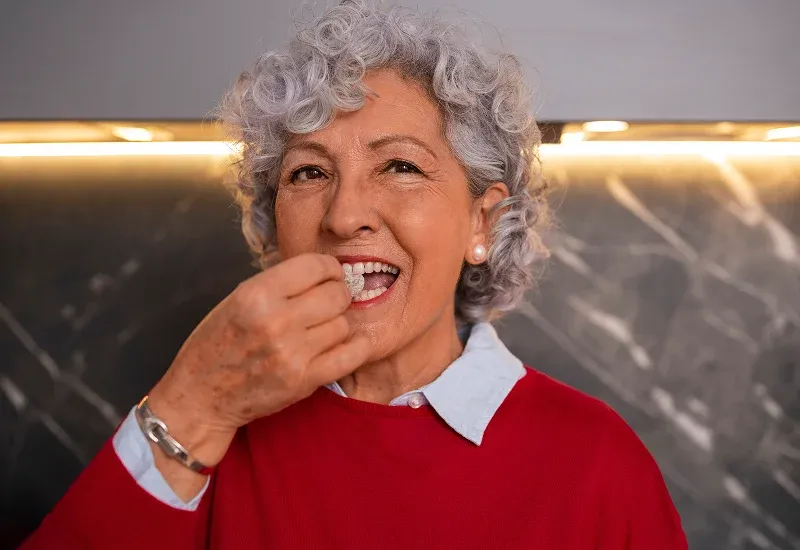Eating with Dental Bridges: What to Expect and How to Adjust?

by Dr. Uvika Singh
13 May 2025

Dental bridges can really help people who have lost teeth. They not only bring back your smile but also help keep your face shape. This will make it easier to chew food. If you are new to dental bridges, you might have some questions about how to eat and adjust to them.
Here we will talk about what to expect when eating with dental bridges, how to change your eating habits, and some handy tips for taking care of your bridges while enjoying meals.

What to Expect After Getting Dental Bridges?
After you get your dental bridges, it's normal to feel some discomfort or sensitivity. The area around the bridge might be a little sore, and your bite may feel different for a while. This is completely normal as your mouth gets used to the new bridge.
Give yourself time to adjust. You might need to change your eating habits for a little while. Pay attention to how your body feels during this time. If you feel pain while eating, it’s a sign to be careful with what you eat.
How to Eat with a Dental Bridge?
Eating with dental bridges can be easy if you follow these tips.
Start with Soft Foods
In the first few days after getting your bridge, stick to soft foods. Things like yogurt, mashed potatoes, and smoothies are great because they won’t put too much pressure on your new dental work.
Chew Carefully
When you chew, try to use both sides of your mouth. This helps spread out the pressure and protects your bridge. Avoid biting hard foods or using your bridge to tear tough items, as this can cause discomfort or damage.
Avoid Sticky Foods
Sticky treats like caramel or taffy can get stuck in your dental bridge and make cleaning difficult. They can also pull on the bridge, which might hurt. Choose easier-to-eat foods that won’t harm your dental work.
Stay Hydrated
Drink plenty of water! It helps wash away food particles and keeps your mouth moist, which is important for good oral health.
Gradually Introduce Solid Foods
As you get more comfortable with your dental bridge, slowly add solid foods back into your diet. Start with softer solids, like cooked vegetables or pasta, before trying tougher foods.
Mind Your Temperature
Your teeth might be sensitive to hot or cold foods and drinks after the procedure. Be careful with extremely hot or cold items until you know how your teeth will react.
Can I Eat Normally with Dental Bridges?
The good news is that most people can return to a normal diet after they’ve fully adjusted to their dental bridges. However, it’s important to remember that some foods may still be off-limits or require careful consumption. While you may not need to completely avoid hard or sticky foods forever, it’s wise to be cautious and listen to your body.
In time, many individuals find that their dental bridges feel just as stable as their natural teeth. It is allowing them to enjoy their favorite foods without worry. Patience and proper care are key during this transition.
What it Feels Like Eating After Getting Dental Bridges?
Eating after getting dental bridges might feel a bit strange at first, but most people adjust quickly. Here are some tips to help you through the change.
Listen to Your Body
If something doesn’t feel right when you’re eating, stop. For example, if you feel sharp pain or discomfort, it might be time to change how you eat or talk to your dentist. Remember, your comfort is important, so don’t hesitate to reach out for help if needed.
Keep Good Oral Hygiene
Taking care of your teeth is very important, especially after eating. Make sure to brush your teeth and clean around the bridge gently but well. Using a soft-bristle toothbrush and toothpaste that isn’t too harsh can help keep your dental work in good shape. Establishing a routine will make it easier to maintain your oral health over time.
Pay Attention to Your Diet
Eating a balanced diet is important for your overall health, and it is especially crucial when you have dental bridges. Include lots of fruits, vegetables, whole grains, and lean proteins in your meals. This will help keep you healthy and take care of your dental bridges. A nutritious diet can also support your healing process and boost your energy levels.
Foods Good for Dental Bridges
When changing your diet after getting dental bridges, here are some food categories that are good for your new dental work.
Soft Fruits
Bananas, applesauce, and berries are great choices. They’re easy to chew and won’t put too much pressure on your bridges. These fruits are also packed with vitamins that are good for your overall health.
Cooked Vegetables
Steamed or boiled veggies like carrots or zucchini are soft and healthy. Just make sure they are cooked until they are tender. Adding a variety of colors to your vegetable choices can provide different nutrients.
Dairy Products
Yogurt, cottage cheese, and soft cheeses are good sources of calcium and protein and are gentle on your dental bridges. These foods can help strengthen your teeth and bones, which is especially important after dental work.
Grains
Soft bread, oatmeal, and pasta are excellent options. They provide energy and are easy on your dental work. Choosing whole grain options can add extra fiber to your diet, which is beneficial for digestion.
Protein
Soft proteins like scrambled eggs, tofu, and fish can be part of your meals. These options are healthy and won’t put stress on your dental bridges. Including a variety of protein sources can help you meet your nutritional needs.
Soups and Broths
Warm soups can be comforting and easy to eat. Just be careful not to make them too hot, as your teeth might still be sensitive after the procedure. Soups can also be a great way to sneak in vegetables and other nutrients.

“A smile remains the most inexpensive gift I can bestow on anyone and yet its powers can vanquish kingdoms.’
– Og Mandido”
Tips for Caring for Dental Bridges While Eating
Proper care while eating is crucial for maintaining your dental bridges. Here are some tips for caring for dental bridges while eating.
- When brushing your teeth, use a soft-bristle toothbrush to avoid damaging your bridges. Gently clean around the bridge area to prevent plaque buildup.
- Flossing is essential to keep the area around your bridge clean. Use a floss threader or a water flosser to help navigate around the dental work without causing damage.
- Regular visits to your dentist are important for monitoring the health of your dental bridges. Your dentist can check for any signs of wear and provide professional cleaning to keep your mouth healthy.
- Foods like nuts, hard candies, and raw carrots can pose a risk to your dental bridges. They can wear over time or even break the bridge if bitten into too forcefully. So, you must choose the right foods for dental bridges to avoid any damage.
Final Thoughts
Eating with dental bridges is a manageable process that requires some adjustments and care. You can enjoy your meals without compromising your dental work. This is possible by starting with soft foods, being mindful of your eating habits, and maintaining good oral hygiene. You will likely find that you can return to enjoying a wide variety of foods with time.
Contact your dentist today in Oakland, Dr. Uvika Singh, at Advance Dental Concepts Oakland, to learn more about Dental Bridges.
Resource:
Share This:
Disclaimer
*This media/content or any other on this website does not prescribe, recommend, or prevent any treatment or procedure. Therefore, we highly recommend that you get the advice of a qualified dentist or other medical practitioners regarding your specific dental condition. *

Subscribe to Our Newsletter
Stay informed about the latest dental news, tips, and promotions by subscribing to our newsletter. Enter your email address below to join our community of smile enthusiasts.
